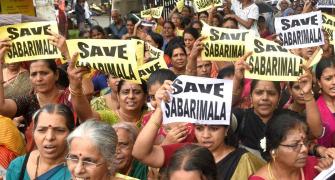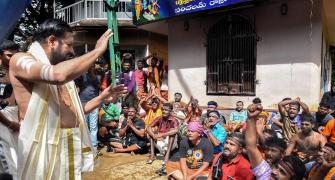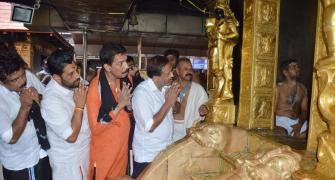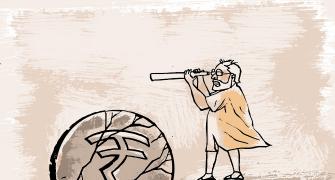Reporter Kavitha Jakkal tried, she failed.
Activist Rehana Fatima tried, she failed.
Activist Trupti Desai tried, she failed.
After several women were prevented from entering the Sabarimala shrine after the Supreme Court verdict upheld their right to do so, Bindu and Kanakadurga managed the seemingly impossible.
Syed Firdaus Ashraf/Rediff.com finds out how they did it.

On January 2, history was made when Bindu, 42, and Kanakadurga, 44, offered prayers at the Sabarimala temple, making them the first women below the age of 50 to enter the shrine.
Bindu and Kanakadurga's efforts came after many other women were prevented from entering the shrine after the Supreme Court struck down a rule that disallowed girls and women in the 10 to 50 age group from entering the temple.
So, what made Bindu and Kanakadurga's efforts different? How was it that they did what no other woman could do?
It all began on November 10 when a bio-medical engineer, identified as Shreyas Kanaran, started a Facebook page called the Navodhana Keralam Sarimalayilekk, to bring about a renaissance in Kerala.
Kanaran, a social activist (he insists that he wants to make it clear that he isn't associated with the Communist Party of India-Marxists) sought women's equality and felt that no one had the right to object to the entry of women into the hill shrine after the Supreme Court order.
"In the past two months, 40 women have become members of our group," says Kanaran, "They all expressed a desire to enter the Sabarimala temple. It was now just a question as to how they would do so with protesters blocking the women's entry."
Filled with determination and a fervent wish to offer prayers to Lord Ayyappa, Bindu and Kanakadurga on December 24 set out on their mission. However, the two women -- who were being escorted by the police -- faced massive protests from devotees at Apachimedu and Marakootam, about one km from the Sannidhanam (temple complex) and were forced to retreat.
Their attempt came a day after 11 other women (part of the Navodhana Keralam Sarimalayilekk group) tried to make their way up the hill, but were forced to return.
It was then that the women went on hunger strike, demanding that the state government and police adhere to the Supreme Court order.
"The police told us they would help enable entry into the temple and so at that point the women gave up their fast," elaborates Kanaran.
Countdown to the entry

It was here that Bindu and Kanakadurga along with psychologist Dr Prasad Amore entered the picture.
He agreed to accompany the women as he too was part of this Facebook group and believed in gender equality. He too like Shreyas Kanaran says he has no association with the Communists.
Dr Amore didn't know Bindu or Kanakadurga beforehand, but his belief in gender equality pushed him to help the two women implement the Supreme Court order.
"We realised that the only way to enter the Sabarimala temple with these women was by using invisible gorilla technique, by creating inattentional blindness (external link). We could not go in broad daylight as many women had tried this before and failed," says Dr Amore.
WATCH: Two women script history, enter Sabarimala temple
So, while the country was gearing up to ring in the New Year, Dr Amore and the women were practising and figuring out every which way they could access the temple.
So meticulous was their planning that they even thought about how they would walk and what they would wear.
Since the operation was a secret, only half a dozen or so people knew about the plan, and even the local police were unaware of the two women's entry.
D-Day's here
On January 2, the police picked up Bindu and Kanakadurga in an ambulance and took them to a hospital, which is close to the shrine, at 1.30 am.
"The plan was to reach the gates of Sabarimala at 3.30 am because as it is very early in the morning no protester would be sitting there expecting women to enter. Moreover, the ambulance helped us to reach the spot without anyone noticing us," recalls Dr Amore.
"Every detail is very important in such times," says Dr Amore. "I told both the ladies that they should look as busy as everyone else so that no one could doubt them. If they showed even the slightest hesitation, people would have suspected something was fishy."
When they finally made their entrance into the complex, a devotee noticed them and tried to create a ruckus. However, the accompanying policemen took him aside and managed to cool him down.
"Many devotees saw Bindu and Kanakadurga entering the temple, but none of them objected. This proves the fact that devotees have nothing against women entering the temple. It is the right-wing organisations that have a problem with women entering the temple," Dr Amore points out.

Prayers and a coffee
And what was the first thing Dr Amore did after coming out of the Sabarimala temple?
"We had a good cup of coffee. We were relaxed as we entered the shrine peacefully and came back," says Dr Amore.
But what if they had got caught and failed?
"We had another plan for the next day with another group of women," says Shreyas Kanaran.
"Even the Devaswom board has no problem with women's entry. It is only the Sangh Parivar which has a problem with women's entry," says Kanaran.
What did they achieve?
"There are always protests while trying something the first time around. When we try it for the second time the crowd relaxes and during the third attempt, they were okay with the women."
"What we did on January 2 was just one step forward. Initially, people from the lower castes were not allowed (in temples), but later, everyone came around. So will be the case of the Sabarimala temple where all people will be okay with women's entry," asserts Kanaran.
"This temple was not a Brahmin temple, but a tribal temple. If you go back in history, this was a Buddhist temple. It was only in the 1990s that this became a Brahmin temple. So this is a big discussion in Kerala -- how can Brahmins prevent the entry of women in a temple?" says Kanaran.
"The Kerala high court judgment of 1991 stopped the entry of women which has now been over-ruled by the Supreme Court of India."









